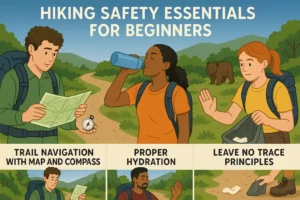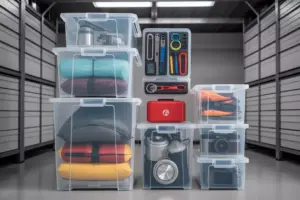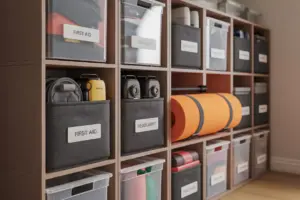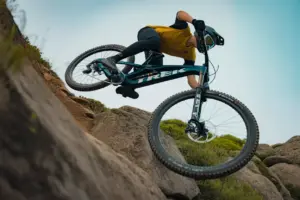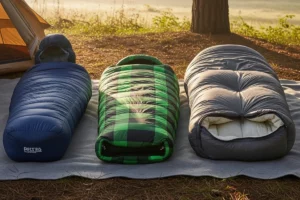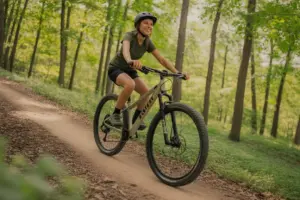How to Choose the Best Camping Grill for You: Backpacking and Car Camping
Picture this: you’re surrounded by towering pines, the campfire crackles nearby, and the aroma of perfectly grilled food fills the crisp mountain air. The difference between a memorable outdoor feast and a disappointing meal often comes down to one crucial piece of equipment – your camping grill. Whether you’re planning a lightweight backpacking adventure or a luxurious car camping getaway, choosing the right grill can make or break your outdoor cooking experience.
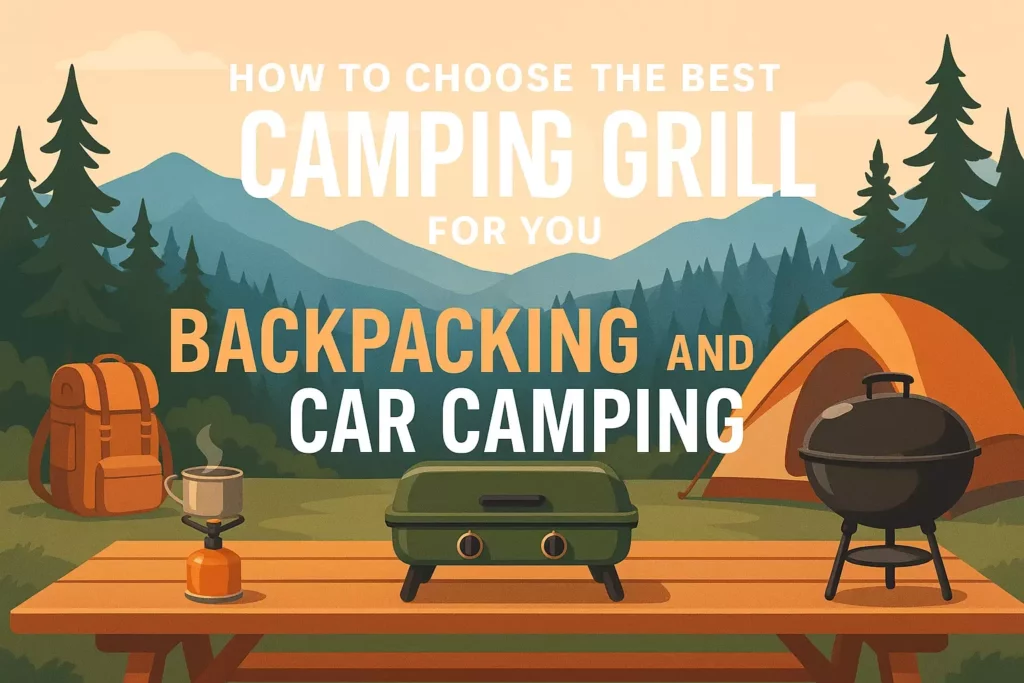
Key Takeaways
- Camping style determines grill type: Backpackers need ultra-lightweight, compact grills while car campers can choose larger, feature-rich models
- Fuel type impacts convenience: Propane offers instant heat control, charcoal provides authentic flavor, and wood-burning grills work anywhere
- Size and weight matter: Consider cooking capacity versus portability based on group size and transportation method
- Essential features include: Wind resistance, easy cleanup, temperature control, and durable construction materials
- Budget range varies widely: Quality camping grills range from $30 for basic models to $300+ for premium features
Understanding Different Types of Camping Grills
Portable Propane Grills 🔥
Propane grills represent the most popular choice for car camping enthusiasts. These grills connect to standard propane canisters and offer instant heat control with the turn of a knob. What is the best camping grill for beginners? Propane models consistently rank highest due to their user-friendly operation.
Advantages:
- Instant ignition and precise temperature control
- Clean burning with no ash cleanup
- Works in most weather conditions
- Available in various sizes
Disadvantages:
- Requires carrying fuel canisters
- Can be heavy for backpacking
- Limited fuel supply in remote areas
Charcoal Camping Grills
For purists who crave that authentic smoky flavor, charcoal grills deliver unmatched taste. These grills use charcoal briquettes or lump charcoal as fuel, creating high heat perfect for searing meats.
Advantages:
- Superior flavor from charcoal smoke
- Reaches very high temperatures
- Fuel is widely available
- Often more affordable than propane models
Disadvantages:
- Longer setup and cleanup time
- Difficult temperature control
- Produces ash and requires disposal
- Not suitable for fire-restricted areas
Wood-Burning Grills
Wood-burning grills offer the ultimate in self-sufficiency, using twigs, branches, and other natural materials as fuel. These eco-friendly options eliminate the need to carry fuel while providing excellent cooking performance.
Advantages:
- No fuel to carry or purchase
- Environmentally friendly
- Works anywhere wood is available
- Often doubles as a campfire
Disadvantages:
- Requires constant fuel feeding
- Smoke production can be heavy
- Not suitable during fire bans
- Learning curve for temperature management
Backpacking vs. Car Camping: What’s the Best Camping Grill for Each?
Backpacking Grill Requirements
When every ounce matters, backpacking grills must prioritize weight and packability above all else. The ideal backpacking grill weighs under 2 pounds and packs down to the size of a laptop.
Essential Features:
- Weight under 2 pounds
- Compact folding design
- Quick setup and breakdown
- Efficient fuel consumption
- Wind resistance
Top Backpacking Grill Types:
- Ultralight wood-burning stoves – Perfect for minimalist camping
- Small propane grills – Reliable and easy to use
- Alcohol-burning grills – Extremely lightweight option
When planning your backpacking gear, remember that a quality grill can replace multiple cooking tools while adding minimal weight to your pack.
Car Camping Grill Options
Car camping opens up a world of possibilities since weight restrictions disappear. What is the best camping grill for car camping depends on your group size, cooking preferences, and desired features.
Ideal Features:
- Large cooking surface (200+ square inches)
- Multiple burners or cooking zones
- Built-in thermometer
- Side tables or prep areas
- Easy-clean surfaces
Popular Car Camping Styles:
- Two-burner propane grills – Versatile and spacious
- Portable charcoal kettles – Great for larger groups
- Hybrid grills – Combine multiple fuel types
For family camping trips, larger grills accommodate multiple dishes and keep everyone fed efficiently.
Key Features to Consider When Choosing Your Camping Grill
Cooking Surface and Capacity
The cooking surface determines how much food you can prepare simultaneously. Measure your needs based on group size:
- Solo camping: 100-150 square inches
- Couples: 150-200 square inches
- Small families: 200-300 square inches
- Large groups: 300+ square inches
Heat Output and Control
Heat output, measured in BTUs (British Thermal Units), indicates how powerful your grill is. However, more isn’t always better – efficient heat distribution matters more than raw power.
BTU Guidelines:
- Backpacking: 5,000-10,000 BTUs
- Car camping: 10,000-20,000 BTUs
- Large groups: 20,000+ BTUs
Wind Resistance and Weather Performance
Outdoor cooking means dealing with wind, which can significantly impact grill performance. Look for:
- Wind screens or shields
- Enclosed burner designs
- Stable, low-profile construction
- Effective wind guards
Portability and Storage
Consider how the grill transports and stores:
- Folding legs and removable parts
- Carrying cases or bags
- Stackable components
- Compact storage footprint
Fuel Types: Pros and Cons
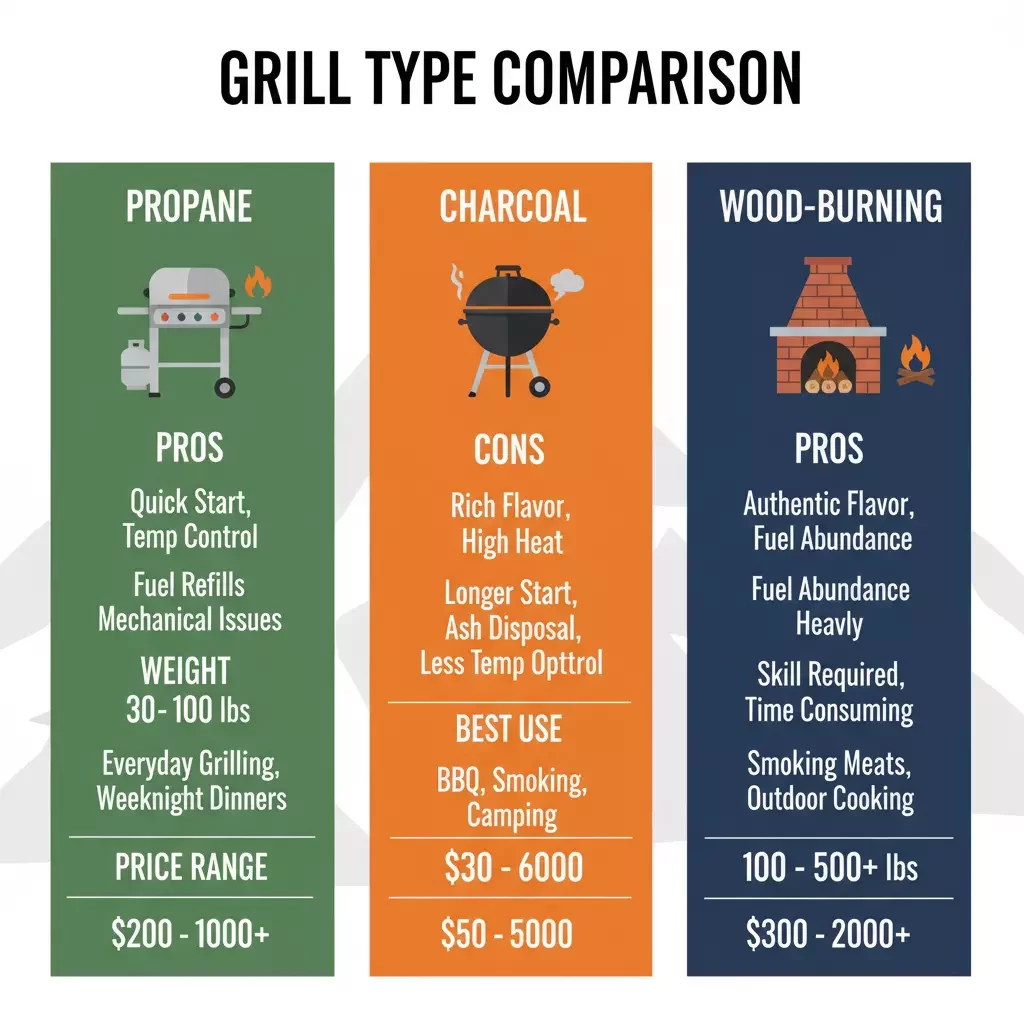
Propane: The Convenient Choice
Propane offers the perfect balance of convenience and performance for most campers. Standard 1-pound canisters provide 1-2 hours of cooking time, while larger tanks offer extended use.
Best for:
- Car camping
- Beginners
- Consistent cooking results
- Quick meal preparation
Charcoal: The Flavor Champion
Charcoal creates intense heat and imparts distinctive smoky flavors impossible to achieve with gas grills. However, it requires more skill and patience to master.
Best for:
- Flavor enthusiasts
- Extended cooking sessions
- High-heat searing
- Social camping experiences
Wood: The Sustainable Option
Wood-burning grills appeal to environmentally conscious campers and those seeking authentic outdoor cooking experiences. They work anywhere wood is available but require constant attention.
Best for:
- Long-term camping
- Bushcraft enthusiasts
- Areas with abundant deadfall
- Minimalist camping approaches
What type of camping do you do most?
How many people do you typically cook for?
What’s your priority?
What’s your budget range?
Answer the questions above to get your personalized camping grill recommendation!
Size and Weight Considerations
Backpacking Weight Limits
Every backpacker knows the golden rule: every ounce counts. When selecting a backpacking grill, prioritize models under 2 pounds that pack down small. Ultra-lightweight options under 1 pound exist for serious gram-counters.
Weight Categories:
- Ultralight: Under 1 pound
- Lightweight: 1-2 pounds
- Standard: 2-3 pounds
- Heavy: Over 3 pounds (avoid for backpacking)
Car Camping Size Freedom
Car camping eliminates weight restrictions, allowing you to choose based on cooking capacity rather than portability. Consider your vehicle’s storage space and setup area when selecting size.
Size Guidelines:
- Compact cars: Grills under 20 inches wide
- SUVs/Trucks: No significant size restrictions
- RVs: Consider permanent mounting options
When setting up your campsite, ensure adequate space around your grill for safe operation and food preparation.
Essential Safety Features and Considerations 🛡️
Stability and Construction
A stable grill prevents accidents and ensures even cooking. Look for:
- Wide, sturdy legs
- Low center of gravity
- Locking mechanisms
- Non-slip feet
Heat Management
Proper heat management protects both cook and equipment:
- Heat-resistant handles
- Thermal barriers
- Proper ventilation
- Temperature indicators
Fire Safety
Always prioritize fire safety, especially in wilderness areas:
- Check local fire restrictions
- Maintain proper clearances
- Have water/extinguisher nearby
- Never leave grill unattended
Consider adding a comprehensive first aid kit to your camping gear for additional safety preparedness.
Budget-Friendly vs. Premium Options
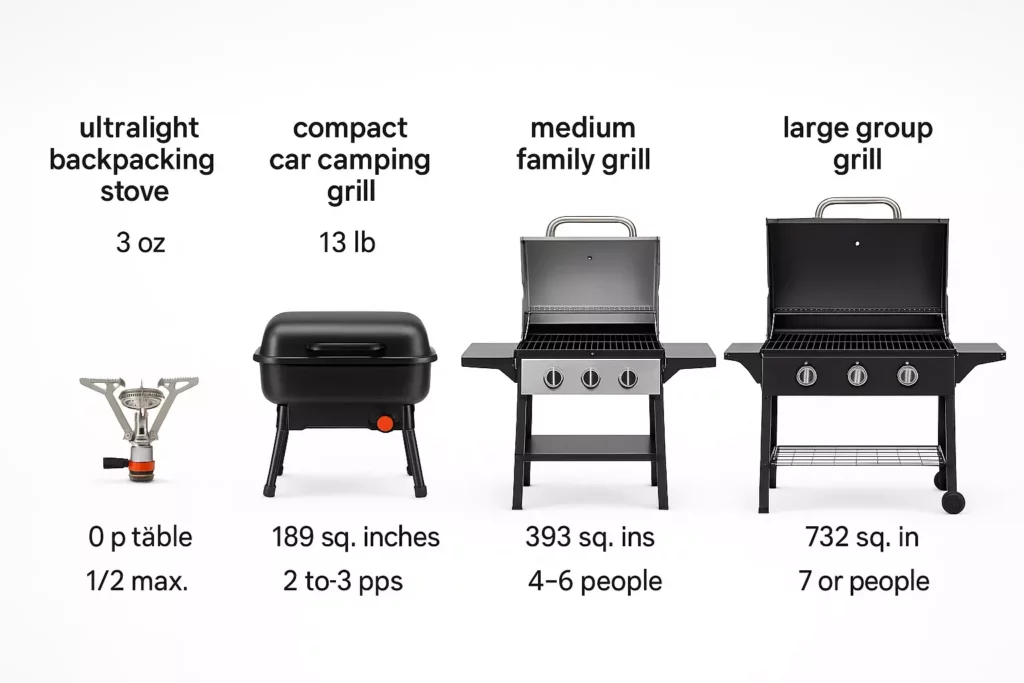
Budget Grills ($30-$75)
Budget grills offer basic functionality without frills. They’re perfect for occasional campers or those testing the waters before investing in premium equipment.
What to Expect:
- Basic materials and construction
- Limited features
- Adequate performance for simple cooking
- Shorter lifespan
Best Budget Picks:
- Single-burner propane grills
- Basic charcoal hibachi-style grills
- Simple wood-burning stoves
Mid-Range Grills ($75-$200)
Mid-range grills provide the sweet spot between features and affordability. They offer better construction, additional features, and improved durability.
Enhanced Features:
- Better materials and build quality
- Multiple cooking zones
- Improved heat distribution
- Wind resistance features
Premium Grills ($200+)
Premium grills justify their cost through superior materials, innovative features, and exceptional durability. They’re ideal for frequent campers who demand the best performance.
Premium Advantages:
- High-grade stainless steel construction
- Advanced heat control systems
- Multiple fuel compatibility
- Lifetime warranties
Maintenance and Care Tips
Cleaning and Storage
Proper maintenance extends grill life and ensures food safety:
After Each Use:
- Clean cooking grates while still warm
- Remove grease and food debris
- Wipe down exterior surfaces
- Check for damage or wear
Long-term Storage:
- Deep clean all components
- Apply protective oil to metal parts
- Store in dry location
- Remove batteries from ignition systems
Seasonal Preparation
Prepare your grill for camping season:
- Inspect gas connections and hoses
- Test ignition systems
- Replace worn gaskets or seals
- Stock up on fuel supplies
Top Camping Grill Recommendations by Category
Best Overall Backpacking Grill
Solo Stove Lite Wood Burning Stove
- Weight: 9 ounces
- Fuel: Twigs, leaves, pellets
- Price: $70-$90
- Best for: Ultralight backpacking
Best Car Camping Grill
Coleman RoadTrip 285 Portable Stand-Up Propane Grill
- Cooking area: 285 square inches
- Features: Three adjustable burners, wheels
- Price: $150-$200
- Best for: Family car camping
Best Budget Option
Coleman Portable Butane Grill
- Weight: 4.7 pounds
- Fuel: Butane canisters
- Price: $35-$45
- Best for: Casual camping
Best Premium Choice
Weber Q1200 Liquid Propane Grill
- Cooking area: 189 square inches
- Features: Cast aluminum construction, thermometer
- Price: $200-$250
- Best for: Serious outdoor cooking
Advanced Features Worth Considering
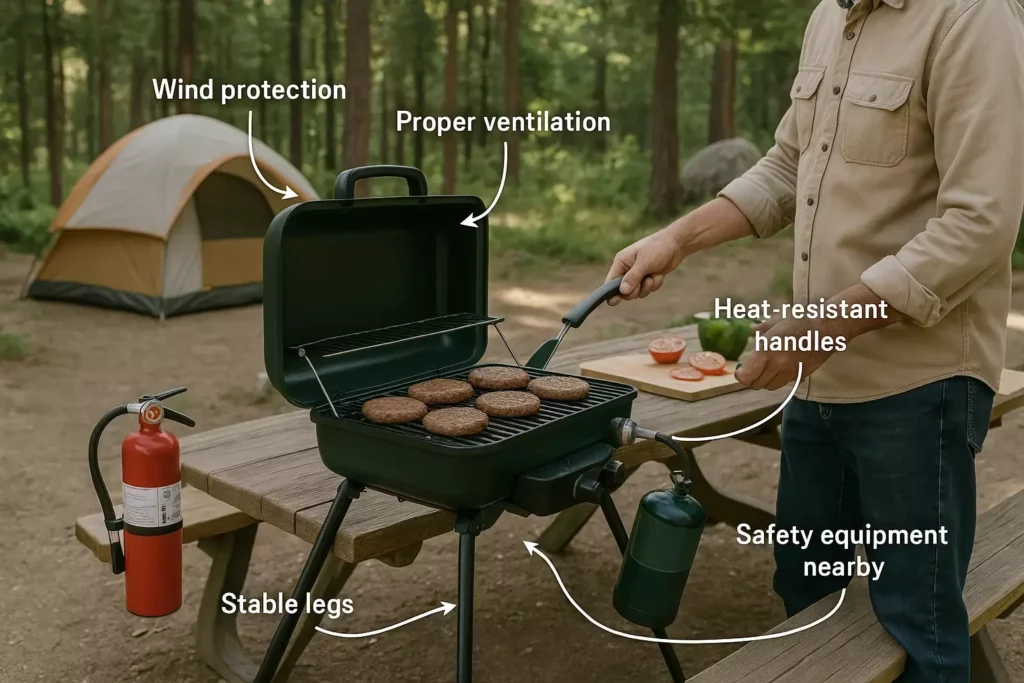
Temperature Control Systems
Advanced grills offer precise temperature management through:
- Built-in thermometers
- Multi-zone heating
- Adjustable air vents
- Heat diffusion plates
Versatility Features
Modern camping grills often include multiple cooking methods:
- Grill grates for direct cooking
- Griddle plates for pancakes and eggs
- Smoker boxes for flavor enhancement
- Rotisserie attachments for whole chickens
Convenience Additions
Premium models may include:
- Side tables for food prep
- Storage compartments
- Tool hooks and holders
- Carrying cases or bags
Making Your Final Decision: What is the Best Camping Grill for You?
Choosing the perfect camping grill requires balancing multiple factors against your specific needs. What is the best camping grill ultimately depends on your camping style, group size, budget, and personal preferences.
Decision Framework
Use this framework to guide your choice:
- Determine your primary camping style (backpacking vs. car camping)
- Assess your group size and cooking needs
- Set your budget range and stick to it
- Prioritize must-have features over nice-to-haves
- Read reviews from actual campers
- Consider long-term value over initial cost
Red Flags to Avoid
Steer clear of grills with these warning signs:
- Extremely cheap prices that seem too good to be true
- Poor customer reviews citing safety issues
- No warranty or support from manufacturer
- Flimsy construction that won’t survive outdoor use
When planning your outdoor cooking strategy, remember that the right grill complements other essential gear. Consider how your grill choice affects your overall camping meal preparation and food storage needs.
Conclusion
Selecting the best camping grill transforms outdoor cooking from a chore into a highlight of your camping experience. Whether you’re a minimalist backpacker seeking ultralight efficiency or a car camping family wanting restaurant-quality meals under the stars, the perfect grill exists for your needs.
Remember that what is the best camping grill varies dramatically based on individual requirements. Backpackers should prioritize weight and packability, while car campers can focus on cooking capacity and features. Consider your fuel preferences, group size, budget constraints, and desired features when making your decision.
Your Next Steps:
- Assess your camping style and typical group size
- Set a realistic budget that balances features with affordability
- Research specific models that match your criteria
- Read user reviews from fellow campers
- Make your purchase and start planning your next outdoor feast
The investment in a quality camping grill pays dividends through countless memorable meals shared around the campfire. Whether you’re flipping burgers for the family or preparing a simple solo dinner after a long day on the trail, the right grill ensures delicious results every time.
Don’t forget to complement your new grill with appropriate camping clothing for various weather conditions and consider how your cooking setup integrates with other camp activities, especially when camping with children.
Start your journey toward better camp cooking today – your taste buds will thank you on every future adventure.

